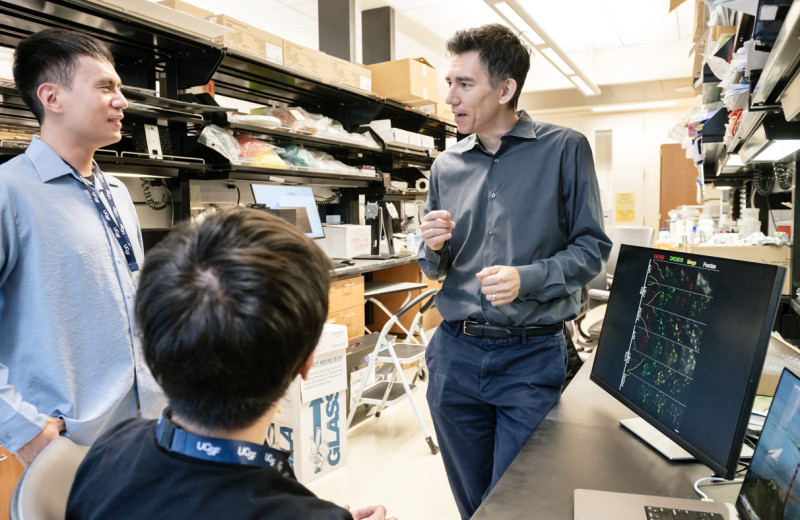Gladstone NOW: The Campaign Join Us on the Journey✕

Dominik Haddad is a postdoctoral scholar in the Nakamura lab. He joined Gladstone after earning a PhD in biomedical science from the University of Leuven in Belgium. [Photo: Chris Goodfellow, Gladstone Institutes]
What brought you to Gladstone?
I was born in Poland and raised in Lebanon, where I graduated with a master’s degree in molecular biology from the Lebanese-American University. Due to economic and political instability, and limited access to laboratory equipment and facilities, I moved to the University of Leuven in Belgium. I did my doctoral training in the laboratory of Dr. Patrik Verstreken and in collaboration with Professor Bart De Strooper, both international leaders in the field of neurodegeneration. In my graduate training, I used Drosophila, or flies, to model several neurological diseases, study their function, and discover molecular pathways. However, mammals are more closely related to humans, so I decided to broaden my knowledge and expertise into mammalian systems.
I joined the Nakamura lab, because this group has excellent and unique expertise in neuroscience, and they share the same interest in studying bioenergetics in neurodegeneration. Additionally, the Gladstone Institutes and the University of California, San Francisco (UCSF) are globally renowned for their innovative and distinguished research. Gladstone, in particular, offers a number of outstanding research facilities and is rated as a top institution for postdoctoral training. By joining Gladstone, I believe that I am placing myself in an ideal research environment that is neuroscience- and disease-focused and will further my scientific growth to prepare me for my career as an independent scientist.
Were you interested in science as a child?
Very early in my childhood, I always wanted to explore and discover the mysteries of life and how our body and brain function. Biology classes were always my favorite. As a child, I was often exposed to the medical field. My father was a physician, and so I spent a lot of time learning in clinics and hospitals. Before college, my dream was to go to medical school to cure patients. It was always in the back of my mind. Then, I took my first laboratory course as a biology major, where I discovered new feelings of excitement and pleasure in lab work and in setting up experiments—a feeling that has remained the same with every experiment I have done for almost a decade now. From that point on, I had a clear vision of what I want to do with my life. I want to become a scientist, and I want to explore disease mechanisms and contribute to potential cures for neurological diseases.
What do you do when you are not working in the lab?
I have great interest in ancient history and philosophy, as well as modern politics, and I enjoy reading and watching documentaries about them in my free time. I also used to play volleyball, my favorite sport, in college. After moving to California, I became more interested in nature hikes, visiting national parks, and exploring San Francisco restaurants and fusion cuisine.
If you could learn to do anything, what would it be?
If I could learn to do something new, I would definitely learn about coding. I believe this will be the future ‘language.’
If you could meet any scientist from any point in time, who would it be and why?
Ibn Sina. He was an ancient philosopher and scientist who wrote Canon of Medicine, a medical encyclopedia that was used in medieval universities for centuries. He discovered so many fascinating things about human anatomy and disease. He was the first to show that some diseases, such as tuberculosis, are contagious, and he described more than 760 medicinal drugs. I think that being a scientist at that era was extraordinarily exciting and challenging, because societies were governed by scholasticism, and new scientific ideas were heretical and potentially punishable by death.
Evidence Builds for Disrupted Mitochondria as Cause of Parkinson’s
Evidence Builds for Disrupted Mitochondria as Cause of Parkinson’s
A new study from Gladstone Institutes strengthens the links between energy breakdown in cells and the onset of Parkinson’s, potentially illuminating new paths for treatment.
News Release Research (Publication) Parkinson’s Disease Neurological Disease Nakamura LabOverworked Brain Cells May Burn Out in Parkinson’s Disease
Overworked Brain Cells May Burn Out in Parkinson’s Disease
A discovery about the consequence of neuron overactivity could lead to new methods of treating or preventing Parkinson’s disease.
News Release Research (Publication) Parkinson’s Disease Neurological Disease Nakamura LabInside the Brain: Tackling Neurological Disease at Its Roots
Inside the Brain: Tackling Neurological Disease at Its Roots
For World Brain Day, discover some of Gladstone’s latest breakthroughs in neurological research.
Gladstone Experts Research (Publication) Alzheimer’s Disease COVID-19 Parkinson’s Disease Neurological Disease Akassoglou Lab Corces Lab Huang Lab Mucke Lab



